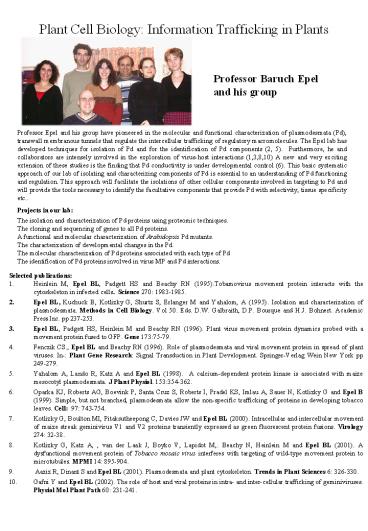Plant%20Cell%20Biology:%20Information%20Trafficking%20in%20Plants - PowerPoint PPT Presentation
Title:
Plant%20Cell%20Biology:%20Information%20Trafficking%20in%20Plants
Description:
The Epel lab has developed techniques for isolation of Pd and for the ... Furthermore, he and collaborators are intensely involved in ... Virology 274: 32-38. ... – PowerPoint PPT presentation
Number of Views:117
Avg rating:3.0/5.0
Title: Plant%20Cell%20Biology:%20Information%20Trafficking%20in%20Plants
1
Plant Cell Biology Information Trafficking in
Plants
Professor Baruch Epel and his group
Professor Epel and his group have pioneered in
the molecular and functional characterization of
plasmodesmata (Pd), transwall membranous tunnels
that regulate the intercellular trafficking of
regulatory macromolecules. The Epel lab has
developed techniques for isolation of Pd and for
the identification of Pd components (2, 5).
Furthermore, he and collaborators are intensely
involved in the exploration of virus-host
interactions (1,3,8,10) A new and very exciting
extension of these studies is the finding that Pd
conductivity is under developmental control (6).
This basic systematic approach of our lab of
isolating and characterizing components of Pd is
essential to an understanding of Pd functioning
and regulation. This approach will facilitate the
isolations of other cellular components involved
in targeting to Pd and will provide the tools
necessary to identify the facultative components
that provide Pd with selectivity, tissue
specificity etc.. Projects in our lab The
isolation and characterization of Pd proteins
using proteomic techniques. The cloning and
sequencing of genes to all Pd proteins. A
functional and molecular characterization of
Arabidopsis Pd mutants. The characterization of
developmental changes in the Pd. The molecular
characterization of Pd proteins associated with
each type of Pd The identification of Pd
proteins involved in virus MP and Pd interactions.
- Selected publications
- Heinlein M, Epel BL, Padgett HS and Beachy RN
(1995).Tobamovirus movement protein interacts
with the cytoskeleton in infected cells. Science
270 1983-1985. - Epel BL, Kuchuck B, Kotlizky G, Shurtz S,
Erlanger M and Yahalom, A (1995). Isolation and
characterization of plasmodesmata. Methods in
Cell Biology. Vol 50. Eds. D.W. Galbraith, D.P.
Bourque and H.J. Bohnert. Academic Press Inc. pp
237-253. - Epel BL, Padgett HS, Heinlein M and Beachy RN
(1996). Plant virus movement protein dynamics
probed with a movement protein fused to GFP. Gene
17375-79. - Fenczik CS., Epel BL and Beachy RN (1996). Role
of plasmodesmata and viral movement protein in
spread of plant viruses. In- Plant Gene
Research Signal Transduction in Plant
Development. Springer-Verlag Wein New York pp
249-279. - Yahalom A, Lando R, Katz A and Epel BL (1998). A
calcium-dependent protein kinase is associated
with maize mesocotyl plasmodesmata. J Plant
Physiol. 153354-362. - Oparka KJ, Roberts AG, Boevink P, Santa Cruz S,
Roberts I, Pradel KS, Imlau A, Sauer N, Kotlizky
G and Epel B (1999). Simple, but not branched,
plasmodesmata allow the non-specific trafficking
of proteins in developing tobacco leaves. Cell
97 743-754. - Kotlizky G, Boulton MI, Pitaksutheepong C, Davies
JW and Epel BL (2000). Intracellular and
intercellular movement of maize streak
geminivirus V1 and V2 proteins transiently
expressed as green fluorescent protein fusions.
Virology 274 32-38. - Kotlizky G, Katz A, , van der Laak J, Boyko V,
Lapidot M,. Beachy N, Heinlein M and Epel BL
(2001). A dysfunctional movement protein of
Tobacco mosaic virus interferes with targeting of
wild-type movement protein to microtubules. MPMI
14 895-904. - Aaziz R, Dinant S and Epel BL (2001).
Plasmodesmata and plant cytoskeleton. Trends in
Plant Sciences 6 326-330. - Gafni Y and Epel BL (2002). The role of host and
viral proteins in intra- and inter-cellular
trafficking of geminiviruses. Physiol Mol Plant
Path 60 231-241.































